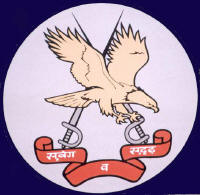Units
Army Aviation Corps
- Details
- Created: 12 October 2006
- Written by Super User
- Hits: 41853

Introduction
Formed on 02 November 1987, the Army Aviation Corps (AAC) currently consists of 38 helicopter flights operated by 12 squadrons. The AAC currently flies 180 helicopters consisting of 60 HAL Chetaks (Alouette II) and 120 HAL Cheetahs (Alouette III). The 80 newest Cheetah airframes are currently in the process of being upgraded/overhauled to the HAL Lancer configuration at the rate of four per month. The HAL Chetaks are organized into six squadrons, which are assigned to Corps HQs. The HAL Cheetahs and HAL Lancers are organized into six squadron establishments, which support independent flights of five helicopters each and are attached to Divisional HQs. The AAC currently has 460 pilot officers on strength and an annual intake of 40-45 officers per year and the AAC Centre is at Nasik, Maharashtra. Army aviation training which was previously carried out at the School of Artillery at Deolali, is now carried out in an independent Combat Air Training School also at Deolali.
The first three HAL Dhruv helicopters were formally delivered to the Indian Army on 20 March 2002 and the AAC is in the process of raising two squadrons of these helicopters. The first of these squadrons is now operational in a testing and tactics development role. The HAL Dhruv will initially replace the Chetak fleet, which was originally obtained second hand from the Indian Air Force. The AAC has recently finished its evaluation of the Mi-17 and Super Puma helicopters for the medium lift role. While the Army prefers the French Super Puma, they are likely to end up with a purchase of Russian Mi-17s to ensure commonality with the extant IAF fleet. In the next plan, the Army will order seven Do-228s for the purposes of liaison. AAC officers have also recently taken over flying of Mi-35 and Mi-25 helicopters, even though the units themselves are owned and administered by the Indian Air Force.
The Cheetah Helicopter Simulator has been set up at the Combat Army Aviation Training School (CATS) at Nashik. It is likely to be introduced at the initial ground training stage of the pilot training, and is expected to substantially reduce costs and risks of pilot training. The trainee pilots of the AAC will be exposed to different weather conditions like rain, snow, storms and of different terrains in addition to night flying, training in handling emergencies, tactical handling of the flying machine, its different maneuvers and more. The project to install a simulator was proposed in December 2000 and approved in April 2002, with CATS Nashik chosen as the centre for installation. Macmet Technologies Ltd, who won the bid over Hindustan Aeronautics Limited (HAL), completed the project by 2005 at a cost of Rs 1.87 crore. After stringent checks, the facility was accepted by the Army in December 2005.
Organisation
This a partial list of the Corps' Army Aviation Squadrons. Each squadron generally consists of two Recce & Observation Flights, which can be interchanged depending on operational requirements. The flights do not lose their identity even when they form part of a squadron. However the term Air Observation Post (AOP) is no longer used in the Corps and has been replaced with the term Recce & Observation (R&O). This list was derived mainly from "Indian Army - A Reference Manual" by Lieutenant Colonel Gautam Sharma.
|
|
This is a list of the R&O Flights which come under the Army Aviation Squadrons. Some R&O Flights operate independently and do not have a parent squadron. They are designated by an (I) in their name to reflect the fact that they are independent. There are also two independent Utility Helo (UH) flights and they adopt the same numbering system as the R&O flights.
|
|
|
|
|
© Army Aviation Corps, Indian Army